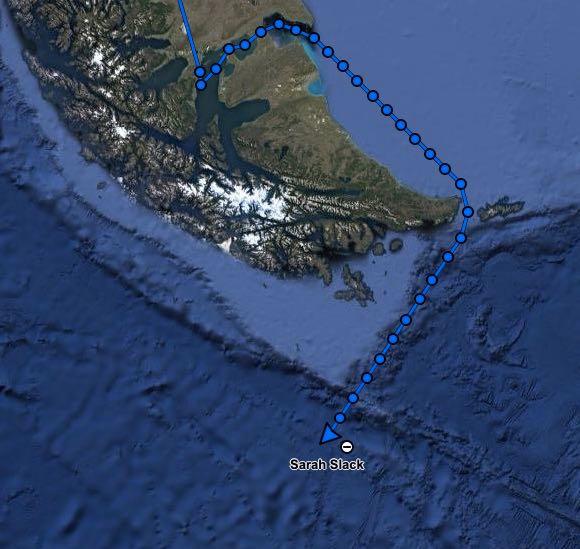Walloping 'Round Cape Horn
Today we began the part of the trip I'm dreading: our transit through Drake Passage. I've been hearing about the conditions of this place for years - when I worked on the Hudson River sloop Clearwater in the early 2000's, we often sang a sea chanty (pronounced shanty) (which reminds me I need to do a future blog post about all the inscrutable vocabulary used exclusively on boats) while hauling lines with crew or with students. The rhythmic pattern of a chanty helps to coordinate the hard work of raising a sail or pulling the anchor back aboard. In most cases, the song leader or shantyman calls out a line and the rest of the crew responds with a repetitive phrase. One of my favorites was South Australia, which you can see [here performed by professionals](
). In this chanty, there are two response lines - the first is "Heave away, haul away," and the second is "We're bound for South Australia." The song includes a two-line call and response followed by a chorus that uses the same responses:
In South Australia I was born
Heave away, haul away
In South Australia 'round Cape Horn
We're bound for South Australia
CHORUS
Haul away you rolling kings (side bar: Rolling Kings is by far the coolest possible name for a bowling team. Take note, Brian Lange)
Heave away, haul away
Haul away you'll hear me sing
We're bound for South Australia
And now the verse that is sending shivers down my spine:
When you go walloping 'round Cape Horn
Heave away, haul away
You'll wish to God you'd never been born
We're bound for South Australia.
That brings me to where I am today - walloping 'round Cape Horn on a ship that is bigger, stronger, and safer than the wooden whaling ships and merchant vessels that used to transport goods and people through this treacherous body of water prior to the construction of the Panama Canal. I'm grateful for my Relief Band and my Dramamine and the bungee cords securing my computer to my table (which is itself bolted to the floor). I know I have it relatively easy, but that doesn't mean this is actually going to be easy.
 The route traveled by the RVIB Nathaniel B. Palmer since departing from Punta Arenas, Chile on January 25.
The route traveled by the RVIB Nathaniel B. Palmer since departing from Punta Arenas, Chile on January 25.
I was curious why the water here in Drake Passage is so rough and how it came to be so notorious. Looking at a world map (and my IS 223 students should be able to do this on the map I left for you), you can see there is no land anywhere in the world along the lines of latitude we are currently crossing (about 56-57 degrees South), which means there is nothing to slow the roll of the ocean. This fast-moving water, called the Antarctic Circumpolar Current, flows at a rate of about 3,400-5,300 million cubic feet per second, which sounds fast but means nothing to me. I do know that the fast-flowing water gets squeezed into the 600-800 miles of open ocean between Cape Horn at the tip of South America and the South Shetland Islands, which are about 100 miles off the tip of Antarctica. The water here in the passage is deep (average 11,000 feet) and it is cold and, I can say from personal observation, it is rough to traverse on a boat. Still images don't begin to do justice to the intimidating rolling swells. Maybe imagine this: I was trying to type this while sitting on the floor of my room (because the floor is the inside place where the seasickness is the least bad) and finally had to climb into a chair because I kept sliding across the floor and almost out the door. I haven't felt this ill since Lucas and Maddy made me go on that stupid roller coaster.
 The notorious waves of Drake Passage crash over the side of the main deck of the Nathaniel B. Palmer as the ship makes its way south from Cape Horn
The notorious waves of Drake Passage crash over the side of the main deck of the Nathaniel B. Palmer as the ship makes its way south from Cape Horn
Activities for Kids:
- Read about these six adventurous guys who rowed through Drake Passage last month
- Write your own sea chanty using South Australia as a model - or find another chanty you like more and give it the Weird Al Yankovic treatment (I once tried to do this using the tune Donkey Riding by Great Big Sea - look up their version on YouTube. You won't be disappointed. My version never made it out of the planning stage).


Comments
Add new comment